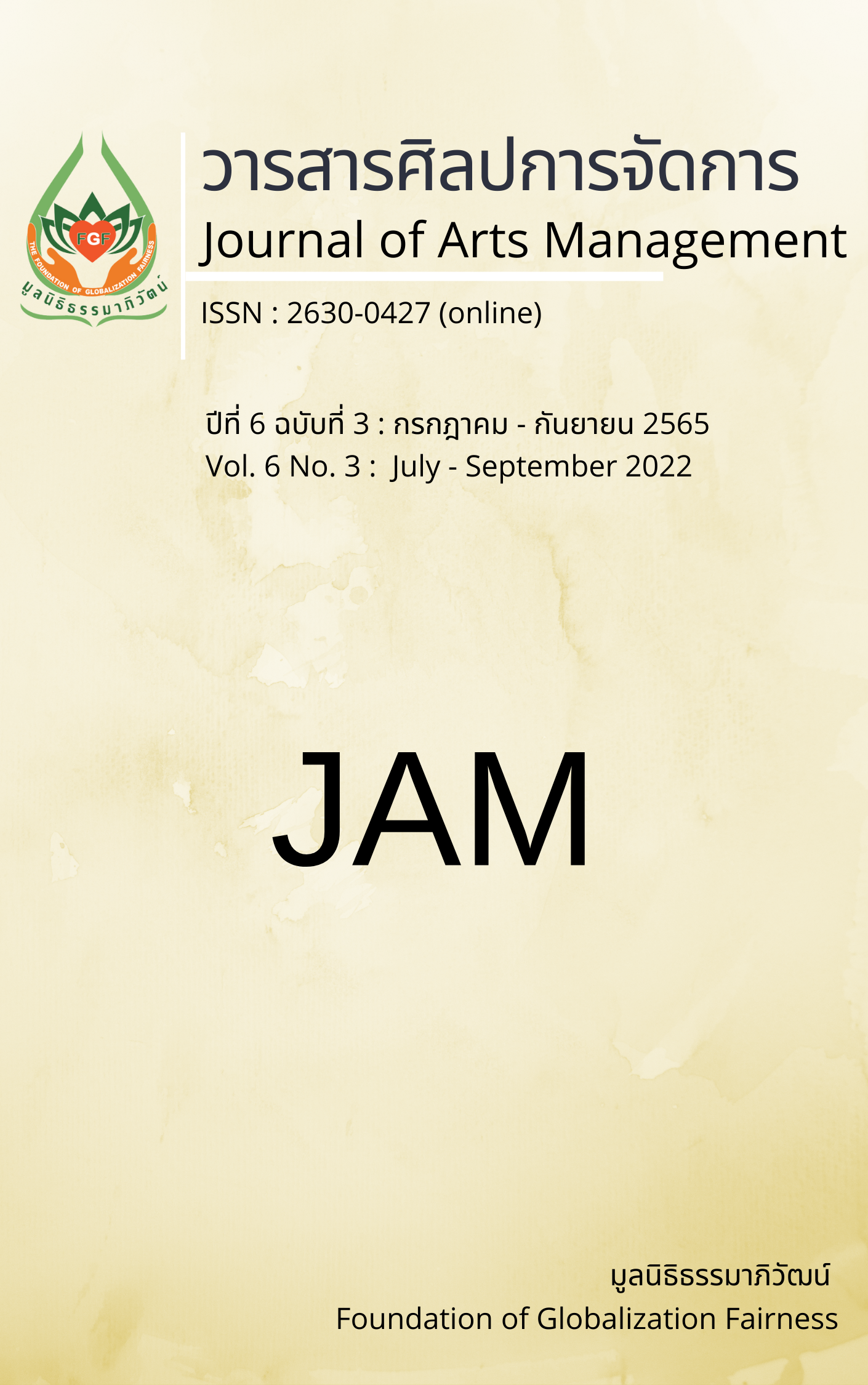The Efficiency of Intellectual Capital on the Performance of Listed Companies in the Stock Exchange of Thailand of the SET100
Main Article Content
Abstract
Intellectual capital is an investment in resources critical to creating corporate value. This article aimed to study the efficiency of intellectual capital on the performance of companies listed on the Stock Exchange of Thailand, SET100. This research was quantitative research combined with documentary research from various published sources by collecting financial information for a period of 5 years from 2017 - 2021 for 100 companies. The VAIC method was to calculate the value-added of intellectual capital by summing the efficiency of the 3 relevant components of capital: Human Capital Efficiency (HCE), Structural Capital Efficiency (SCE), and Capital Employed Efficiency (CEE). To find the relationship to performance as measured by the Return on Asset (ROA), Return on Equity (ROE), and Net Profit Margin (NPM). The statistics used to analyze the data are maximum, minimum, mean, standard deviation, Pearson correlation coefficient, and testing the hypothesis by using multiple regression analysis.
The results showed that the added value of intellectual capital, which is the sum of the performance of the three relevant intellectual capital components, has no relation to the performance of the entity. There is only the efficiency component of capital employed, that is related to the performance of the business as measured by Return on Asset and Return on Equity at a.01 level of significance. This indicates that the use of the entity's tangible assets is still necessary to create value and performance for the entity.
Article Details

This work is licensed under a Creative Commons Attribution-NonCommercial-NoDerivatives 4.0 International License.
Views and opinions appearing in articles in the Journal of Arts of Management It is the responsibility of the author of the article. and does not constitute the view and responsibility of the editorial team I agree that the article is copyright of the Arts and Management Journal.
References
Andreou, A. N., Green, A., & Stankosky, M. (2007). A framework of intangible valuation areas and antecedents. Journal of Intellectual Capital, 8(1), 52-75. https://doi.org/10.1108/1469193071 0715060
Butsalee, P., & Sincharoonsak, T. (2020). Intellectual capital as an enterprise value measurement. Academic Journal of Buriram Rajabhat University, 12(1), 127-141.
Clarke, M., Seng, D., & Whiting, R. H. (2010). Intellectual capital and firm performance in Australia. Journal of Intellectual Capita, 12(4), 505-530. https://doi.org/10.1108/14691931111181706
Gold, A., Malhotra. A., & Segars, A. (2001). Knowledge management: An organizational capabilities perspective. Journal of Management Information Systems, 18(1), 185-214. https://doi.org/10.1080/07421222.2001.11045669
Jiraudomsarod, P., Petchchedchoo. P., & Kumsuprom, S. (2020). The relationship between intellectural capital and market value of the firms. Suthiparithat Journal, 34(110), 128-144.
Kewsuwun, N., & Theppaya, T. (2021). Knowledge Management to Intellectual Capital of Business Organizations in Thailand. Journal of Humanities and Social Sciences Nakhon Phanom University, 11(1), 346-359.
Khong-in, W. (2016). The impact of board composition intellectual capital reporting and market value: a case study of listed companies in the stock exchange of Thailand[Master’s Thesis, Prince of Songkla University].
Klaewtanong, A. (2020). The relationship between intellectual capital disclosures on earnings quality and market values of Thai listed companies in technology sector. Suthiparithat Journal, 32, (102), 98-112.
Laing, G., Dunn, J., & Hughes‐Lucas, S. (2010). Applying the VAIC™ model to Australian hotels. Journal of Intellectual Capital, 11(3), 269-283. https://doi.org/10.1108/146919310110 64545
Malina, H. M. K. (2012). Intellectual Capital and Firm Performance of Commercial banks in Malaysia. Asian Economic and Financial Review, 2(4), 577-590.
María Díez, J., Lizet Ochoa, M., Begoña Prieto, M., & Santidrián, A. (2010). Intellectual capital and value creation in Spanish firms. Journal of Intellectual Capital, 11(3), 348-367. https://doi.org/10.1108/14691931011064581
Mavridis, D. G. (2004). The intellectual capital performance of the Japanese banking sector. Journal of Intellectual capital, 5(1), 92-115. https://doi.org/10.1108/14691930410512941
Nassar, S. (2018). The impact of intellectual capital on firm performance of the Turkish real estate companies before and after the crisis. European Scientific Journal, 14(1), 29-45. https://doi.org/10.19044/esj.2018.v14n1p29
Pulic, A. (2000). VAICTM: An accounting tool for IC management. International Journal Technology Management, 20(5–8), 702-714. https://doi.org/10.1504/IJTM.2000.002891
Roos, G., & Roos, J. (1997). Measuring your company's intellectual performance, Long Range Planning, 30(3), 413-426. https://doi.org/10.1016/S0024-6301(97)90260-0
Teece, D. J. (2000). Strategies for managing knowledge assets: The role of firm structure and industrial context. Long Range Planning, 33(1), 35-54. https://doi.org/10.1016/S0024-6301(99)00117-X
Thamprasart, P., & Phajongwong, P. (2018). The relationship between intellectual capital and firm performances of listed companies on the stock exchange of Thailand. MUT Journal of Business Administration, 15(1), 171-192.
Sharabati, A., Jawad, S., & Bontis, N. (2010). Intellectual capital and business performance in the pharmaceutical sector of Jordan. Management Decision, 48(1), 105-131. https://doi.org/10.1108/00251741011014481
Sungmala, N., & Verawat, A. (2021). The impact of socio-demographic factors on employee engagement at multinational companies in Thailand. Journal of Multidisciplinary in Humanities and Social Sciences, 4(2), 694-711.
Zhao, S. (2021). Combined AHP-TOPSIS-IPA and statistical analyses for implications to one belt one road initiatives. International Journal of Multidisciplinary in Management and Tourism, 5(2), 100-121. https://doi.org/10.14456/ijmmt.2021.10


